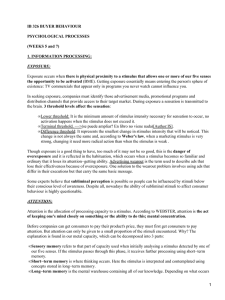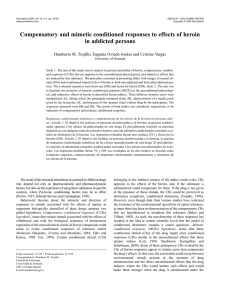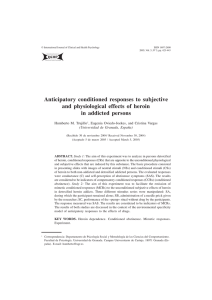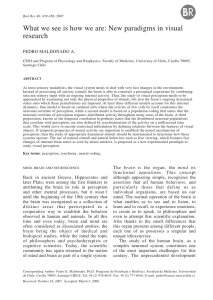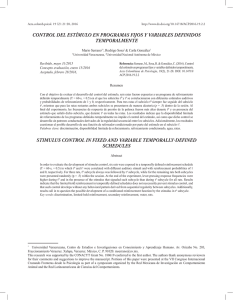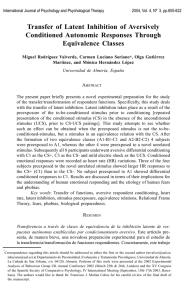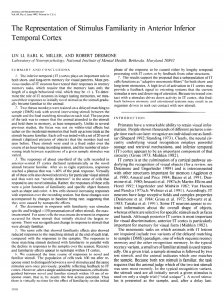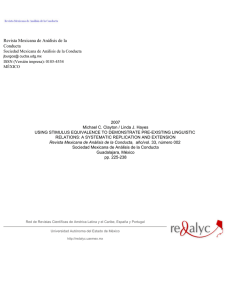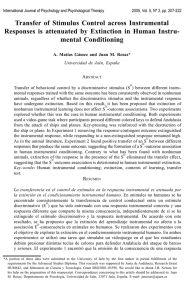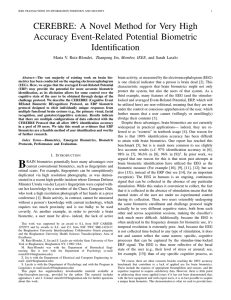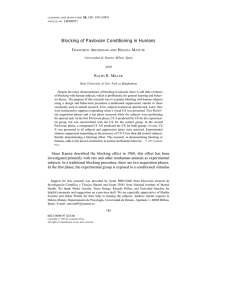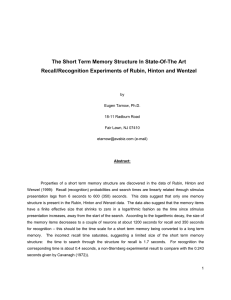Buyer behaviour
Anuncio
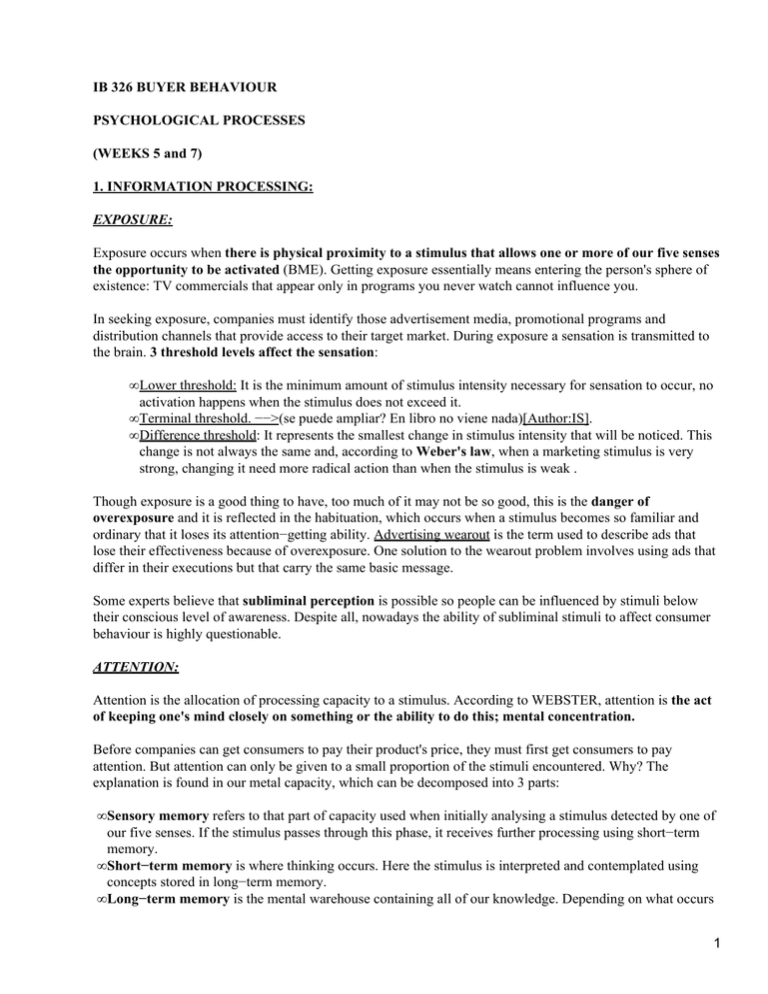
IB 326 BUYER BEHAVIOUR PSYCHOLOGICAL PROCESSES (WEEKS 5 and 7) 1. INFORMATION PROCESSING: EXPOSURE: Exposure occurs when there is physical proximity to a stimulus that allows one or more of our five senses the opportunity to be activated (BME). Getting exposure essentially means entering the person's sphere of existence: TV commercials that appear only in programs you never watch cannot influence you. In seeking exposure, companies must identify those advertisement media, promotional programs and distribution channels that provide access to their target market. During exposure a sensation is transmitted to the brain. 3 threshold levels affect the sensation: • Lower threshold: It is the minimum amount of stimulus intensity necessary for sensation to occur, no activation happens when the stimulus does not exceed it. • Terminal threshold. −−>(se puede ampliar? En libro no viene nada)[Author:IS]. • Difference threshold: It represents the smallest change in stimulus intensity that will be noticed. This change is not always the same and, according to Weber's law, when a marketing stimulus is very strong, changing it need more radical action than when the stimulus is weak . Though exposure is a good thing to have, too much of it may not be so good, this is the danger of overexposure and it is reflected in the habituation, which occurs when a stimulus becomes so familiar and ordinary that it loses its attention−getting ability. Advertising wearout is the term used to describe ads that lose their effectiveness because of overexposure. One solution to the wearout problem involves using ads that differ in their executions but that carry the same basic message. Some experts believe that subliminal perception is possible so people can be influenced by stimuli below their conscious level of awareness. Despite all, nowadays the ability of subliminal stimuli to affect consumer behaviour is highly questionable. ATTENTION: Attention is the allocation of processing capacity to a stimulus. According to WEBSTER, attention is the act of keeping one's mind closely on something or the ability to do this; mental concentration. Before companies can get consumers to pay their product's price, they must first get consumers to pay attention. But attention can only be given to a small proportion of the stimuli encountered. Why? The explanation is found in our metal capacity, which can be decomposed into 3 parts: • Sensory memory refers to that part of capacity used when initially analysing a stimulus detected by one of our five senses. If the stimulus passes through this phase, it receives further processing using short−term memory. • Short−term memory is where thinking occurs. Here the stimulus is interpreted and contemplated using concepts stored in long−term memory. • Long−term memory is the mental warehouse containing all of our knowledge. Depending on what occurs 1 in short−term memory, new information may be passed along for storage into long−term memory. We'll focus on short−term memory, for it's this part of mental capacity that's being allocated when something catches our attention. Short−term memory is a limited mental resource with limited size and capacity: we can process only a certain amount of information at a time. That's why our cognitive system monitors inputs to the senses and chooses some for processing in the preattentive processing. Thus, for marketers, getting attention is a major hurdle . Two types of factors influence which ones receive attention, personal determinants and stimulus determinants: PERSONAL DETERMINANTS: • Needs/motivation: people are particularly attentive to stimuli perceived as relevant to their needs. Connecting to consumers' needs may require reminding them of their needs before showing them how the product can satisfy these needs . • Attitudes: We all try to minimise inconsistencies in attitudes and beliefs. • Adaptation level: Even the largest stimuli get less noticeable in time. • Attention span: Short attention span causes marketers problems. STIMULUS DETERMINANTS: • Position: Stimuli may be more noticeable simply because of where they are located in the environment. A rule of thumb in advertising is that the upper−left hand corner of the page is the most likely to receive attention. • Colour: One−colour ads produce 41% more sales than did their black & white counterparts. Moreover, some colours may be more attention−getting than others . • Size: In general, the larger the stimulus, the more it tends to stand out and draw attention. Consequently, an easy way for companies to attract attention is to simply make things bigger. • Intensity: Have you ever noticed that the volume of a commercial is sometimes much louder than the programming that preceded it? This is far from accidental !!. • Movement: Stimuli in motion are more likely to attract attention than stationary objects. • Scene changing (contrast): The use of rapid−fire scene changes can cause an involuntary increase in brain activity. • Spokes person: Famous individuals or celebrities are popular bait. Many companies hire celebrities to endorse their products. And even non−celebrities can grab attention, especially if they are attractive. • Learned attention−inducing stimuli: Certain word or phrases can attract consumers' attention because they have learned that these words are associated with things they desire (e.g.: Direct Line and the red phone with wheels and the music tiririri tiri tiri). COMPREHENSION: Beyond trying to get to think about their products, companies also try to get you to think and feel about their products in a certain way: • This is the domain of comprehension that involves the interpretation of a stimulus. • It is the point at which meaning is attached to the stimulus. • And both stimulus categorisation and elaboration affect the meaning given to a stimulus: • Stimulus categorisation is the process of categorising concepts stored in memory. How a stimulus is categorised is important because the particular mental categories to which a stimulus is assigned affect the opinions formed about the stimulus. (The person tries to answer the question what is it? answering this question involves stimulus categorisation in which the stimulus is classified using the 2 mental concepts and categories stored in memory). • Stimulus elaboration is how much stimulus is elaborated during its processing. • There are personal and stimulus determinants in comprehension: • Personal: Knowledge, motivation, expectation. • Stimulus: Linguistics, order effects, context. • How people organise the stimulus is the domain of Gestalt psychology, the area concerned with how people organise stimuli to make them meaningful. There are 3 principles that help the companies to make their ads easier to be recalled: • Simplicity: given the reality that consumers are usually unwilling to invest much of their cognitive resources into processing advertising messages, advertisers often opt for simple messages that can be easily comprehended. • Use of figure and ground. • Closure (Schh you know how) . ACCEPTANCE: Acceptance focuses on the persuasive effective of a stimulus. This persuasiveness may be reflected by influencing knowledge, attitudes and even behaviour. Acceptance depends on cognitive and affective responses: * Cognitive responses are the thoughts during comprehension, which must balance arguments for and against and can supplement attitude measures to gain insight into success or failure of a marketing communication. Example: we might think about how tired we are of seeing the same commercial over and over −−>(todo esto es un poco raro pero en el libro no viene desarrollado). [Author:IS] * Affective responses are how the stimulus makes people feel. Obviously they work in combination with cognitive responses. There is a wide range of feelings possible (upbeat, negative or warm). Example: we might feel amused by a commercial's humor. RETENTION: Retention involves the transfer of stimulus interpretation and persuasion into long−term memory. This transfer is not the same in all of us, it depends on: • Physiological properties: the brain has 2 hemispheres connected by the corpus callosom, the left hemisphere (LHS) is the centre of logic, abstract and conceptual thinking, and the right hemisphere (RHS) is the centre for creative, intuitive and imaginal thinking. Depending on the more importance of either the left part or the right one, our retention process will differ. • Multiple store theory of the memory (to study the differences between sensory, short and long−term memory, check page 2). 2. CONSUMERS TO REMEMBER (LEARNING) Consumers learn from past experience, and future behaviour is conditioned by such learning. As consumers gain experience in purchasing and consuming products, they learn brands they like and do not like and the features they like most in particular brands. They then adjust future behaviour based on past experience throughout the learning: the process by which experience leads to changes in knowledge, attitudes and 3 behaviour. There are 3 approaches of thought in understanding the process of consumer learning: The behaviourist approach and the cognitive approach. In BEHAVIOURIST APPROACH, learning is shown by behaviour change due to a link being developed between stimuli and response, and the mental processing is ignored. Two different points of view can be identified: • Classical conditioning: This theory is reflected in Pavlov's famous experiments: Pavlov reasoned that because his dogs salivated (unconditioned response) at the sight of food (unconditioned stimulus), a conditioned stimulus such a bell, could also caused the dogs to salivate (conditioned response, same as the unconditioned one), if it was closely associated with the unconditioned stimulus (food). The 2 key concepts are repetition and contiguity. The conditioned stimulus (bell) must be frequently repeated in close contiguity to the unconditioned stimulus (food) to establish a conditioned response (salivate). The behaviourist approach can be applied to marketing in an effort to associate a product with a positive stimulus, but they have to bear in mind some constraints: • There should be no other stimuli that could overshadow the unconditioned stimulus: Be especially careful with the cultural differences. • Unconditioned stimuli should have no previous associations to other brands or product categories: Otherwise the blocking effect will appear. • The unconditioned stimulus should not be overly familiar and presented alone: Consumers could become oversaturated with certain stimuli that frequently appear in the mass media (known as preexposure effect). • Classical conditioning is more effective when the conditioned stimulus is new: The association would probably be ineffective because of prior associations consumers have with the brand (latent inhibition). • Instrumental conditioning: This point of view also requires the development of a link between a stimulus and response, but behaviour results in an evaluation of degree of reward or punishment obtained from past behaviour, affecting the likelihood of behaviour happening again : if consumer enjoys a new product, may buy again. Instrumental conditioning comes closer than classical conditioning to describing the formation of habit in consumer purchasing. The consumer has control over his or her purchasing behaviour through reinforcement (positive, negative or punishment reinforcement) so, for example, continuous positive reinforcement (satisfaction) resulting from product usage increases the probability that the same brand will be purchased (see below). −−−−−−−−−−−−−−−−−−−−−−−−−−−−−−−−−−−−−−−−−−−−−−−−−−−−−−−−−−−−−−−−−−−−−−−−−−−−−−−−−−−−− −−−−−−−−−−−−−−−−−−−−−−−−−−−−−−−−−−−−−−−−−−−−−−−−−−−−−−−−−−−−−−−−−−−−−−−−−−−−−−−−−−−−− −−−−−−−−−−−−−−−−−−−−−−−−−−−−−−−−−−−−−−−−−−−−−−−−−−−−−−−−−−−−−−−−−−−−−−−−−−−−−−−−−−−−− On the other hand, the COGNITIVE APPROACH views learning as a problem solving process rather than the development of connections between stimulus and response. Cognitive learning is a process of perceiving stimuli, associating stimuli to needs, evaluating alternative brands, and assessing whether expectations have been met. In a way, it is focused on understanding how information is transferred into long−term memory (the mental process). 4 The 2 main determinants in the cognitive approach are rehearsal and elaboration: • Rehearsal (ABC..ABC..ABC) involves the mental repetition of information or, more formally, the recycling of information through short−term memory. Rehearsal serves 2 main functions. First, it allows for the maintenance of information in short−term memory. Secondly, it involves the transfer of information from short−term memory to long−term memory. • Elaboration concerns how much the stimulus is related to existing knowledge during processing (A= *B= *C= *). The more elaboration, the better the learning. Elaboration is influenced by individual ability and motivation: sometimes people deliberately try to learn so they can later remember the information (called intentional learning ), and sometimes learning occurs despite the absence of the intention to do so (called incidental learning ). As one would expect, learning is greater when it's intentional than incidental. Finally, the VICARIOUS APPROACH combines aspects from cognitive and behaviourist theories and occurs when people change their behaviour as a result of observing the behaviour of others. Vicarious learning affects people's behaviour in 2 ways: • If they see positive consequences from the behaviour of others, they will imitate it. • If they see negative consequences, they will avoid the behaviour. A lots of advertising uses this approach: E.g.: mums cooks great meal using packet sauce and family smile and say how great it is. 3. HELPING CONSUMERS TO REMEMBER There are some techniques to help consumers to remember causing a very effective execution of the campaign: REMINDERS: It involves reminding them what the company wants them to remember. Methods: • To place retrieval cues on the product's packaging; such cues would consist of some image strongly associated with the ad itself (Eg: Energizer batteries and the drum−playing pink bunny). • To use two different commercials, each emphasising different aspects, and so encouraging reactivation of the memories supplied by the other commercial. REPETITION: By showing their ads repeatedly. Learning grows with additional exposures, although at a diminish rate (each successive exposure contributes less to memory than the preceding one), until it plateaus, at which point further repetition is unproductive, so further repetition beyond this point is a waste of money (wear−out). It is for this reason that companies should develop multiple ad executions carrying the same basic message. ENCOURAGE ELABORATION: By encouraging consumers to engage in elaboration during processing, companies can make it easier for consumers to remember. It is also achieved through self−referencing, which involves relating a stimulus to one's own self and experiences. THE IMPORTANCE OF CONSISTENCY: Consistency facilitates remembering. Greater consistency among elements within an advertisement increases what consumers remember about the ad and advertised product. The product benefits described within an ad are better remembered when these benefits are consistent with those suggested by the advertised product's name . USE EASY TO REMEMBER STIMULI: Words themselves differ in how easily they are remembered. 5 Concrete words are more likely than abstract words to evoke a visual representation in memory, thereby providing an additional pathway for later retrieval. The memory advantage held by concrete words should be considered when developing new brand names. E.g.: consumers may only notice a price cut for an expensive item if the price cut is large * SALE! Luxury liner half price, save millions!!. About 20 ads can be exposured each time, but we can only remember 3 or 4: this is the selection process. Consumers typically see 300 ads each day, 100 of theses on the TV. TV ad: Hungry? Then SNICKERS. Red car drivers are more inclined to speed Se refiere a anuncios para completar, raros, inacabados que son más recordados por la gente. Reward will increase the probability of repeating the behaviour; punishment will decrease that probability. La diferencia con classical conditioning está en el ejemplo que puso con los ratones, si cada vez que pisan cierto peldanyo tienen descarga eléctrica, aprenden y no lo hacen más, es un ejemplo de negative reinforcement. E.g.: Studying a text book. E.g.: Reading a newspaper. Eg: Smooth as ice Icy cold. Icy clear. Imported Icy Vodka of Iceland. Why can't everything in life be this smooth?. IB 326 Buyer Behaviour (Weeks 5 and 7): Psychological processes 1 ANTECEDENT STIMULI OPERANT BEHAVIOUR PRESENTATION OF POSITIVE REINFORCEMENT POSITIVE REINFORCEMENT ANTECEDENT STIMULI OPERANT BEHAVIOUR REMOVAL OF ADVERSE STIMULUS NEGATIVE REINFORCEMENT ANTECEDENT STIMULI OPERANT BEHAVIOUR PRESENTATION OF ADVERSE STIMULUS 6 PUNISHMENT 7
